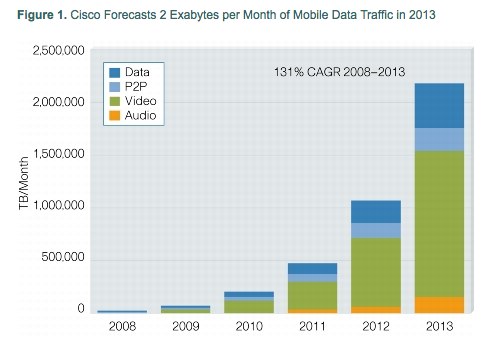Studies: more mobile traffic, mobile video in coming years

Mobile computing is here - and it's only going to get bigger, according to projection studies released this week.
Cisco Systems today released the results of its Visual Networking Index (VNI) Mobile Forecast for 2008-2013. The big projection in that study is that global mobile traffic will increase 66-fold between 2008 and 2013, a forecast that reflects the pending arrival of 4G mobile Internet connections, the key to increased use of mobile video and greater access to other mobile broadband services. In the report, Kelly Ahuja, senior vice president of Cisco's service provider routing technology group, said:
More personalized services and applications are becoming available on a wide range of devices. The key to success will be delivering video-rich any-play services to users, enabling them to move freely throughout the world while maintaining connectivity to others. As a result, service providers will have to take into account the need not only for more bandwidth when planning their network architecture but for greater network intelligence as well.
Among the highlights from that study:
- Global mobile traffic will exceed two exabytes (1 billion gigabytes) per month by 2013.
- Mobile broadband handsets with higher than 3G speeds and laptop air or data cards will constitute more than 80 percent of global mobile traffic by 2013.
- Nearly 64 percent of the world's mobile traffic will be video by 2013.
- Mobile video will grow at a compound annual growth rate of 150 percent between 2008 and 2013.

Speaking of mobile video, Global IP Solutions released the findings of a separate survey this week on the topic. In a nutshell, the survey found that mobile operators and equipment vendors also see mobile video heading into the mainstream, over the next few years. Some of the highlights from that study:
- More than half of U.S. wireless carriers plan to launch - or increase access to - real-time video services in the next two years.
- As a way of competing with the big guys, smaller carriers are upping their mobile Internet offerings and are going after third-party apps to enhance communications on the device.
- Nearly half of the carriers surveyed are "enthusiastic" about delivering open platforms for third-party software developers.
An excerpt from the report:
Significant additional service rollouts are generally expected to occur within the next two years. Respondents cited various drivers behind the emergence of real-time video on the network. Sprint views real-time video as a “communication mechanism,” including video chat, for rollout in the “near term,” suggesting timelines of up to a year. Verizon seems bullish regarding video and real-time video.